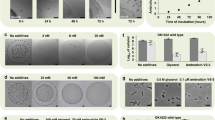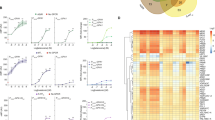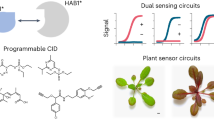Abstract
The construction of synthetic cell-cell communication networks can improve our quantitative understanding of naturally occurring signaling pathways and enhance our capabilities to engineer coordinated cellular behavior in cell populations. Towards accomplishing these goals in eukaryotes, we developed and analyzed two artificial cell-cell communication systems in yeast. We integrated Arabidopsis thaliana signal synthesis and receptor components with yeast endogenous protein phosphorylation elements and new response promoters. In the first system, engineered yeast 'sender' cells synthesize the plant hormone cytokinin, which diffuses into the environment and activates a hybrid exogenous/endogenous phosphorylation signaling pathway in nearby engineered yeast 'receiver' cells. For the second system, the sender network was integrated into the receivers under positive-feedback regulation, resulting in population density–dependent gene expression (that is, quorum sensing). The combined experimental work and mathematical modeling of the systems presented here can benefit various biotechnology applications for yeast and higher level eukaryotes, including fermentation processes, biomaterial fabrication and tissue engineering.
This is a preview of subscription content, access via your institution
Access options
Subscribe to this journal
Receive 12 print issues and online access
$209.00 per year
only $17.42 per issue
Buy this article
- Purchase on Springer Link
- Instant access to full article PDF
Prices may be subject to local taxes which are calculated during checkout




Similar content being viewed by others
References
Mok, D.W. & Mok, M.C. Cytokinin metabolism and action. Annu. Rev. Plant Physiol. Plant Mol. Biol. 52, 89–118 (2001).
Inoue, T. et al. Identification of CRE1 as a cytokinin receptor from Arabidopsis. Nature 409, 1060–1063 (2001).
Lu, J.M., Deschenes, R.J. & Fassler, J.S. Saccharomyces cerevisiae histidine phosphotransferase Ypd1p shuttles between the nucleus and cytoplasm for SLN1-dependent phosphorylation of Ssk1p and Skn7p. Eukaryot. Cell 2, 1304–1314 (2003).
Li, S. et al. The yeast histidine protein kinase, Sln1p, mediates phosphotransfer to two response regulators, Ssk1p and Skn7p. EMBO J. 17, 6952–6962 (1998).
Maeda, T., Wurgler-Murphy, S.M. & Saito, H. A two-component system that regulates an osmosensing MAP kinase cascade in yeast. Nature 369, 242–245 (1994).
Hohmann, S. Osmotic stress signaling and osmoadaptation in yeasts. Microbiol. Mol. Biol. Rev. 66, 300–372 (2002).
Li, S. et al. The eukaryotic two-component histidine kinase Sln1p regulates OCH1 via the transcription factor, Skn7p. Mol. Biol. Cell 13, 412–424 (2002).
Melcher, K., Sharma, B., Ding, W.V. & Nolden, M. Zero background yeast reporter plasmids. Gene 247, 53–61 (2000).
Mateus, C. & Avery, S.V. Destabilized green fluorescent protein for monitoring dynamic changes in yeast gene expression with flow cytometry. Yeast 16, 1313–1323 (2000).
Suzuki, T. et al. The Arabidopsis sensor His-kinase, AHK4, can respond to cytokinins. Plant Cell Physiol. 42, 107–113 (2001).
Kakimoto, T. Biosynthesis of cytokinins. J. Plant Res. 116, 233–239 (2003).
Takei, K., Sakakibara, H. & Sugiyama, T. Identification of genes encoding adenylate isopentenyltransferase, a cytokinin biosynthesis enzyme, in Arabidopsis thaliana. J. Biol. Chem. 276, 26405–26410 (2001).
Takei, K., Yamaya, T. & Sakakibara, H. Arabidopsis CYP735A1 and CYP735A2 encode cytokinin hydroxylases that catalyze the biosynthesis of trans-Zeatin. J. Biol. Chem. 279, 41866–41872 (2004).
Miller, M.B. & Bassler, B.L. Quorum sensing in bacteria. Annu. Rev. Microbiol. 55, 165–199 (2001).
Janiak-Spens, F., Sparling, D.P. & West, A.H. Novel role for an HPt domain in stabilizing the phosphorylated state of a response regulator domain. J. Bacteriol. 182, 6673–6678 (2000).
Janiak-Spens, F. & West, A.H. Functional roles of conserved amino acid residues surrounding the phosphorylatable histidine of the yeast phosphorelay protein YPD1. Mol. Microbiol. 37, 136–144 (2000).
Ferber, D. Synthetic biology. Microbes made to order. Science 303, 158–161 (2004).
Weiss, R. et al. Genetic circuit building blocks for cellular computation, communications, and signal processing. Nat. Comput. 2, 47–84 (2003).
Kramer, B.P., Fischer, C. & Fussenegger, M. BioLogic gates enable logical transcription control in mammalian cells. Biotechnol. Bioeng. 87, 478–484 (2004).
Weiss, R. & Knight, T.F. in DNA computing, Lecture Notes in Computer Science, vol. 2054 (eds. Condon, A. & Rozenberg, G.) 1–16, (Springer, New York, 2001).
Bulter, T. et al. Design of artificial cell-cell communication using gene and metabolic networks. Proc. Natl. Acad. Sci. USA 101, 2299–2304 (2004).
Basu, S., Mehreja, R., Thiberge, S., Chen, M.T. & Weiss, R. Spatiotemporal control of gene expression with pulse-generating networks. Proc. Natl. Acad. Sci. USA 101, 6355–6360 (2004).
Basu, S., Gerchman, Y., Collins, C.H., Arnold, F.H. & Weiss, R. A synthetic multicellular system for programmed pattern formation. Nature 434, 1130–1134 (2005).
Kobayashi, H. et al. Programmable cells: interfacing natural and engineered gene networks. Proc. Natl. Acad. Sci. USA 101, 8414–8419 (2004).
Bardwell, L. A walk-through of the yeast mating pheromone response pathway. Peptides 25, 1465–1476 (2004).
Chen, H., Fujita, M., Feng, Q., Clardy, J. & Fink, G.R. Tyrosol is a quorum-sensing molecule in Candida albicans. Proc. Natl. Acad. Sci. USA 101, 5048–5052 (2004).
Farmer, W.R. & Liao, J.C. Improving lycopene production in Escherichia coli by engineering metabolic control. Nat. Biotechnol. 18, 533–537 (2000).
You, L., Cox, R.S., III, Weiss, R. & Arnold, F.H. Programmed population control by cell-cell communication and regulated killing. Nature 428, 868–871 (2004).
Wildt, S. & Gerngross, T.U. The humanization of N-glycosylation pathways in yeast. Nat. Rev. Microbiol. 3, 119–128 (2005).
Toman, P.D. et al. Production of recombinant human type I procollagen trimers using a four-gene expression system in the yeast Saccharomyces cerevisiae. J. Biol. Chem. 275, 23303–23309 (2000).
Weber, W. et al. Engineered Streptomyces quorum-sensing components enable inducible siRNA-mediated translation control in mammalian cells and adjustable transcription control in mice. J. Gene Med. 7, 518–525 (2005).
Williams, S.C. et al. Pseudomonas aeruginosa autoinducer enters and functions in mammalian cells. J. Bacteriol. 186, 2281–2287 (2004).
Neddermann, P. et al. A novel, inducible, eukaryotic gene expression system based on the quorum-sensing transcription factor TraR. EMBO Rep. 4, 159–165 (2003).
Mumberg, D., Muller, R. & Funk, M. Yeast vectors for the controlled expression of heterologous proteins in different genetic backgrounds. Gene 156, 119–122 (1995).
Mumberg, D., Muller, R. & Funk, M. Regulatable promoters of Saccharomyces cerevisiae: comparison of transcriptional activity and their use for heterologous expression. Nucleic Acids Res. 22, 5767–5768 (1994).
Gueldener, U., Heinisch, J., Koehler, G.J., Voss, D. & Hegemann, J.H. A second set of loxP marker cassettes for Cre-mediated multiple gene knockouts in budding yeast. Nucleic Acids Res. 30, e23 (2002).
Sheff, M.A. & Thorn, K.S. Optimized cassettes for fluorescent protein tagging in Saccharomyces cerevisiae. Yeast 21, 661–670 (2004).
Acknowledgements
We thank Y. Gerchman, D. Karig, S. Basu and S. Subramanian for helpful discussions. We also thank T. Kakimoto and S. Avery for the gift of yeast strain and plasmids and R. Kerstetter for A. thaliana genomic DNA extract. This work was supported by a Burroughs Wellcome Fund fellowship.
Author information
Authors and Affiliations
Corresponding author
Ethics declarations
Competing interests
The authors declare no competing financial interests.
Supplementary information
Supplementary Fig. 1
Simulated cytokinin receiver behavior. (PDF 74 kb)
Supplementary Fig. 2
Simulated quorum sensing behaviors. (PDF 80 kb)
Supplementary Table 1
Definitions. (PDF 42 kb)
Supplementary Table 2
Chemical Reactions. (PDF 536 kb)
Supplementary Table 3
Differential Equations. (PDF 19 kb)
Supplementary Table 4
Kinetic Constants (units in μM and minute). (PDF 80 kb)
Supplementary Table 5
Plasmids used in this work. (PDF 45 kb)
Supplementary Table 6
Yeast strains used in this study. (PDF 32 kb)
Rights and permissions
About this article
Cite this article
Chen, MT., Weiss, R. Artificial cell-cell communication in yeast Saccharomyces cerevisiae using signaling elements from Arabidopsis thaliana. Nat Biotechnol 23, 1551–1555 (2005). https://doi.org/10.1038/nbt1162
Received:
Accepted:
Published:
Issue Date:
DOI: https://doi.org/10.1038/nbt1162
This article is cited by
-
Synthetic biology for the engineering of complex wine yeast communities
Nature Food (2022)
-
Hydrogel-based biocontainment of bacteria for continuous sensing and computation
Nature Chemical Biology (2021)
-
Integrated proteomic and metabolomic analysis of a reconstructed three-species microbial consortium for one-step fermentation of 2-keto-l-gulonic acid, the precursor of vitamin C
Journal of Industrial Microbiology and Biotechnology (2019)
-
Synthetic gene regulation for independent external induction of the Saccharomyces cerevisiae pseudohyphal growth phenotype
Communications Biology (2018)
-
Molecular Communication over Gas Stream Channels using Portable Mass Spectrometry
Journal of the American Society for Mass Spectrometry (2017)



